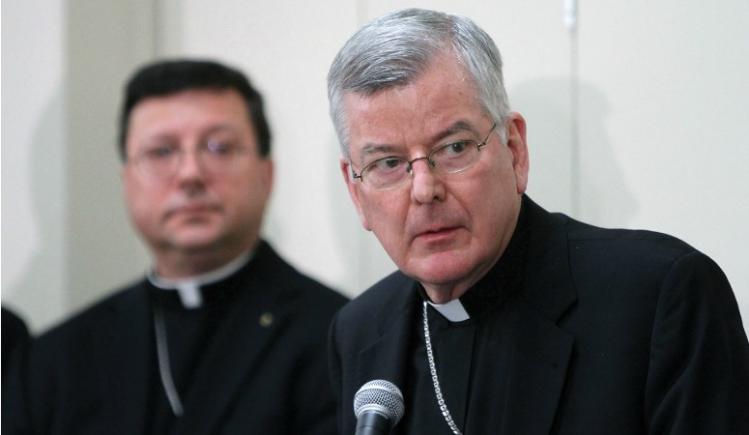
In Water Shaping Stone, the Catholic moral theologian Kathryn Lilla Cox explains that she did not set out to write a book on “conscience and conscience formation,” but that the subject was chosen for her by events close to home. Cox is referring to the way Archbishop John Nienstedt of St. Paul and Minneapolis inserted himself into the middle of the state’s 2012 referendum on same-sex marriage, and to the scandals that arose in her local church about the hierarchy’s response to clergy sexual abuse. In the aftermath, Cox’s students at St. John’s School of Theology in Collegeville, and members of church groups across the state, kept asking her to address questions of episcopal authority and Catholic freedom of conscience. The new book is the result of those events.
In it, Cox seeks to “dismantle two competing and false understandings of conscience,” in which conscience is reduced either to “personal experience, thought, or feeling as the sole arbiter of truth” or, on the other hand, to “a course of action dictated by authority.” Cox looks to the recently deceased Catholic moral theologian Anne Patrick for a better, richer construal of conscience. A mature conscience, Patrick has written, requires both formation and the recognition of each individual’s moral agency. This view becomes the twofold thesis of Cox’s book: “Loyalty to the Magisterium can co-exist with dissent properly understood,” and not all disagreement with church teaching amounts to dissent.
I take that thesis to be fundamentally true, along with the related conclusions Cox comes to. As she notes, recent official church teaching is not entirely clear or consistent in its presentation of conscience. Where Vatican II—and especially Gaudium et spes—tended to present conscience and its formation as a communal search for truth, Pope John Paul II emphasized the need for it to be formed in conformity with established church teaching. Cox provides a brief overview of conscience in Scripture, church history (especially Aquinas and Newman), and the thinking of two contemporary Catholic theologians, Anne Patrick and Bernhard Häring. She does not take a position on the debate, ongoing since medieval times, about whether conscience is more a matter of will (“heart”) or intellect (“head”), but instead gives us many lists of the “aspects,” “components,” or “dimensions” of human beings that need to be brought together in moral deliberation. Cox holds that, because conscience formation has so often been reduced to the church providing information (“magisterial teaching”), we should stop using the term “formation” altogether and speak instead about the process of becoming mature moral agents.
When so-called “dissent” is about the application of church teaching in particular circumstances rather than its substance, Cox says it is not dissent at all and is completely compatible with loyalty to the magisterium. All of us in the church, she counsels, must come to “see ourselves as partners in a common endeavor of seeking truth for living the Gospel as disciples.” Cox also takes on the topic of scandal, an idea too often wielded to quash dissent. Here she juxtaposes two understandings of scandal, one sociological (she returns to the mishandling of clergy sexual abuse), and the other theological (she uses James Cone’s parallel between our history of lynching black Americans and the first-century powerbrokers’ crucifying Jesus). The former type of scandal undermines the faith of believers and needs to be eliminated. But the latter, she argues, is “unavoidable in a life of Christian discipleship”: for if we really follow Jesus, our consciences will be scandalized by, and moved to act against, the injustices all around us.
THERE ARE MANY important insights in this book, yet at its close I felt something had gone missing—namely, a sustained reflection on the church. For I take the fundamental failure at the base of our hardened positions on conscience—positions Cox rightly rejects—to be a failure of awareness about what the church is and why we need it so badly. In the words of Cardinal Walter Kasper, we are failing to “live the church”; as Pope Francis warns, we have become sick inside the cocoon of our entrenched positions; we need to go outside, get dirty, and risk an accident.
Archbishop Nienstedt (who has resigned as our archbishop since Cox’s book went to print) did not just overplay his magisterial hand. He failed to “live the church,” placing himself above the rest of us and in the process effectively withdrawing from the church. And haven’t many of the rest of us, in response to similar behavior by too many bishops, been fleeing as well, no longer darkening the church doors? In doing so, we are harming both ourselves and the church.
Vatican II is both clearer and more foundational on the church’s role in forming consciences than Cox acknowledges. Gaudium et spes says (four times) that church is where all of us need to come for the healing of our vires—the powers of our human soul, classically understood as intellect, will, sense perception, and emotion. We need to be transformed together because, as Aquinas put it, sin has set our vires into “vehement” opposition with one another. In fleeing into our respective camps, we have become distorted caricatures of human beings.
Cox is right that we need to grow in maturity as moral agents, and that we need a relationship with “the Triune God.” But more must be said about how this happens. And Vatican II says more:
It is the task of the laity to cultivate a properly informed conscience and to impress the divine law on the affairs of the earthly city. For light and power (vires) let them turn to the clergy; but let them realize that their pastors will not always be so expert as to have a ready answer to every problem, even every grave problem, that arises. This is not the role of the clergy. (GS 43)
We need the clergy to gather us into the life of the church because our vires, our souls, are fractured, and we are not whole. We need the church because, as novelist Douglas Coupland writes in Life After God, we are “sick and can no longer make it alone.” Our engagement with each other in the life of the church is our way of relating to the Triune God, and it is our conscience formation. Cox’s title is meant as a metaphor for conscience formation; she writes that it “alludes to the manner in which God works on our hearts of stone.” But water shapes stone relentlessly, inexorably wearing it down over geological eons; the metaphor is both too impersonal and too implacable to describe the kind of formation we need. Again, Vatican II has a far more personal and urgent understanding of how we are “shaped” in the church: “Let the faithful, then, try to guide each other by sincere dialogue in a spirit of mutual charity and with a genuine concern for the common good above all.”
It’s worth noting that the Latin fideles refers to all the baptized, lay and clerical alike. This reminds us that reversing the trend toward withdrawal from the life of the church will demand mutual growth and mutual renunciation of false certainties. For all its intelligent focus on conscience, Water Shaping Stone leaves us wanting more about exactly how we come to moral decisions, and why the formation of conscience is so important. Perhaps a good subtitle for a more complete book on the subject might be Becoming Human by Living the Church. We need the church in order to do just that, as much as the church needs us.
Please email comments to [email protected] and join the conversation on our Facebook page.
Previous Story
'The Practice of Catholic Theology'
Next Story
'You Are What You Love'


